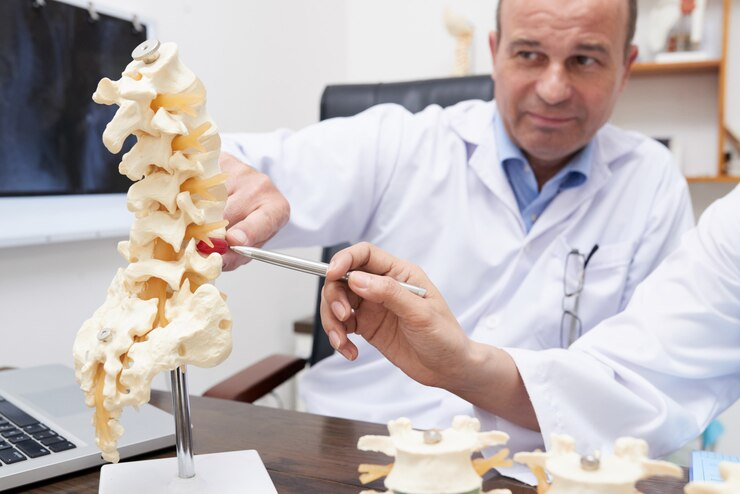What is Ankylosing Spondylitis?
A form of arthritis (inflammation or swelling of one or more joints) that primarily affects the spine.
It causes spinal joint (vertebrae) inflammation, leading to severe pain and discomfort.
This pain results from inflammation of the joints (sacroiliac joints), and the inflammation is called sacroiliitis.
The inflammation then spreads to the joints, eventually affecting the whole spine and causing spondylitis.
In advanced cases, spine movement gradually becomes limited due to ankylosis (new bone formation in the spine), causing a fixed and immobile position. This progressive fusion is called ankylosis.
Ankylosing spondylitis can cause inflammation, pain, and stiffness in other joints, including the shoulders, hips, heels, and small joints of the hands and feet. In some cases, the eyes can become involved, and the lungs and heart can rarely be affected.
Symptoms of Ankylosing Spondylitis
The symptoms usually develop between 20-30 years of age and develop slowly over months or years.
The symptom of ankylosing spondylitis also varies significantly from person to person.
However, knowing the warning signs can help. The most common warning signs include:
- Back Pain Early in the Morning or at Night
- Pain in Hips and Shoulder Joints
Other Symptoms Include:
- Early Morning Stiffness
- Poor Posture or Dropping Shoulders
- Loss of Appetite
- Weight Loss
- Fever and Fatigue
- Anemia (Lack of Hemoglobin)
- Reduced Lung Function
Other Rare Symptoms Include:
- Inflammation of the Bowels
- Eye Inflammation
- Heart Inflammation
- Inflammation in the foot
What Are the Risk Factors Associated with Ankylosing Spondylitis?
- Family history
- Age
- Sex
- Other arthritic and rheumatic disorders
- More common in males than females
How is Ankylosing Spondylitis Diagnosed?
There are no definitive tests used to diagnose ankylosing spondylitis. The doctor will check your symptoms and family history and conduct a physical exam.
Other tests include:
- Magnetic resonance imaging (MRI) scans
- X-rays
- Blood tests
What is the Treatment for Ankylosing Spondylitis?
The treatment aims to relieve pain and stiffness and prevent complications. Ankylosing spondylitis treatment is more successful if diagnosed early.
The doctor may prescribe certain medications to help relieve pain, inflammation, and stiffness; however, they also might cause gastrointestinal bleeding. If medications are not helpful, your doctor might suggest injections through an intravenous line.
Physical therapy is another essential part of treatment and can help relieve pain and improve strength and flexibility. Specific physical exercises include:
- Stretching exercises
- Strengthening exercises for abdominal and back
- Correcting sleeping and walking positions
Most people with ankylosing spondylitis will not need surgery. Surgery may be recommended if you have severe pain or damage to your hip joint.
Preventing Measures and Lifestyle Changes
Lifestyle changes can help manage symptoms of ankylosing spondylitis:
- Stay active: Regular exercise can help relieve pain and maintain flexibility to improve your posture
- Practice Good Posture: Practicing standing straight can help you avoid a few problems associated with ankylosing spondylitis
- Eating Healthy Diet: Foods rich in Omega-3 Fatty Acids, Whole Grains, Fruits, and Vegetables
- Avoid Unhealthy Foods: Eliminate foods rich in fat, sugar, and sodium, and other highly processed foods
- Drink Plenty of water
- Quit Alcohol and Smoking
What are the Complications of Ankylosing Spondylitis?
Ankylosing spondylitis can affect your day-to-day life and lead to additional health complications.
- Inflammation of the joints in the pelvis, shoulders, hips, and knees
- Inflammation between the spine and ribs
- Spinal fractures (broken vertebrae)
- Jaw inflammation
- Painful eye inflammation
- Sensitivity to light (photophobia)
- Heart diseases
- Chest pain that affects breathing
When to Consult a Doctor?
Consult a doctor if you have the following issues:
- Severe chest pain
- Difficulty breathing
- Vision problems
- Painful back or joint pain
- Rigidity of the spine
- Unexplained weight loss
Make a list of:
- Your symptoms
- Recent lifestyle changes
- Family medical history
- All medications and supplements you take
Myth: Ankylosing Spondylitis Is Just Back or Spine Pain
Fact: Ankylosing Spondylitis is a systemic disease that affects multiple parts of joints and organs. It primarily affects the lower back and buttocks but also causes pain in the peripheral joints (hips and hands). It also leads to inflammation around the heart, lungs, and eyes. People with Ankylosing Spondylitis have significant fatigue, which affects sleep, cognitive function, and mental health.
Myth: Diet and Exercise will Cure Ankylosing Spondylitis
Fact: Ankylosing spondylitis is a progressive condition that worsens over time, leading to disability. There is no complete cure for Ankylosing spondylitis; however, the symptoms can be treated. Exercise is the first-line defense against Ankylosing Spondylitis progression.



